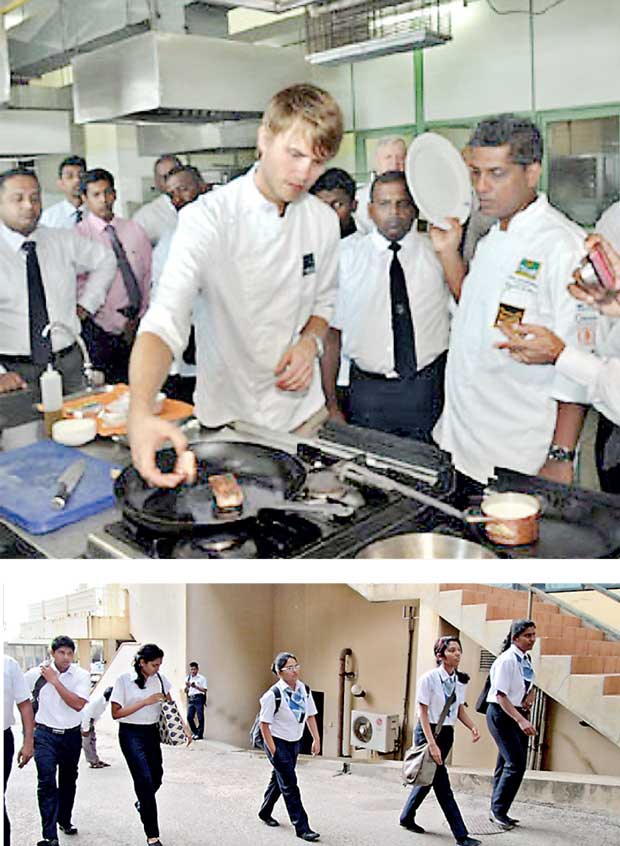
.jpg)
There is no doubt that the tourism industry in Sri Lanka is developing in leaps and bounds, with arrivals already passing the one million mark in July this year. Hotel development is taking place rapidly, with many new entrants to the industry. The latest information from the Sri Lanka Tourism Development Authority (SLTDA) indicates that as at May 2015, there are 195 new hotel projects that have been approved and are in the pipeline. A large number of new travel agencies also have cropped up, while several new airline carriers are expected to start operations to Sri Lanka this year.
While all these frenzied development activities are going on, one area that has been grossly neglected is the development of the human resource in tourism.
Environment
International tourism today is changing radically and the basic ‘hotel experience’ is no longer good enough. The wholesome visitor experience is what matters and needs to be exceptional in today’s fiercely competitive international arena. Similarly, customers are more information and Internet savvy, concerned about lifestyle and environmental issues, demanding an authentic and personalized experience.
While technology and IT can certainly help the tourism industry to operate more efficiently in this environment, ‘high tech’ will never, and can never, replace the ‘high touch’. Warm personalized customer service, professionally delivered, will never ever be replaced by any amount of technology. This personalized service and experience can then only be delivered by high-quality, properly trained professional staff.
Hence, it is obvious, that the hospitality industry needs to breed new human capital, with a vast array of soft skills and professionalism, to be competitive and be successful in this changing environment.
Development of human capital for the industry
Traditionally the hospitality trade has been dependent on conventional professional skills development, with minimal development of the soft management skills. The emphasis and focus has been on the technical aspect of the job, with very little emphasis placed on the softer aspect of attitudes, interpersonal relationships, communication skills, etc.
.jpg)
In Sri Lanka, this is much more prevalent, and today, and with the industry maturing, we are beginning to see the results of these shortcomings. The expectation gap in the service delivery is rapidly increasing and no longer is our ‘Sri Lankan Smile’ adequate to ‘wow’ our customers.
Certainly with the strong industry growth and moving into the limelight of the country’s business area, more and more young people are showing interest in joining the hospitality industry. This is a major change from five to 10 years ago, when unfortunately the hospitality industry was the last resort for young people as a career, after exhausting all other possible opportunities. However, there seems to be a major lack of awareness of the demands of the hospitality trade among new entrants and the need to have the prerequisite soft skills to make it a successful career development.
Supply
Sri Lanka has only one proper government hotel school, which was set up in 1966 and was positioned at that time to be one of Asia’s best hotel training institutes. Since then, quality and standards have depreciated rapidly. In spite of this, it is the only proper state-owned institute, which provides reasonably good hospitality training. The main hotel school in Colombo and its six satellite schools can produce not more than 3,000 trained and qualified students per annum. There are several other private institutions, which have cropped up to meet the demand, providing hospitality education and training - some good, some mediocre and some bad.
Even with all these peripheral training institutes, the ‘total output’ of all these institutions put together, would not be more than 5,000 per annum.
Hence, putting aside the quality of education and training for the moment, would this quantity be sufficient to meet the future industry needs?
.jpg)
Demand
Assessing the demand for staffing of the Sri Lanka hotel industry in the future is indeed a difficult task. However, without resorting to ‘crystal ball gazing’, there are a few analytical methods that can be used to at least gauge ‘the appropriate numbers’ required. (See chart)
These are conservative estimates using direct prorated calculations. With enhanced tourism products and services coming online, staff to room/tourists ratio could be higher, because of the more personalized services offered (even today, the staff to room ratio in the newer boutique hotels is much higher than in conventional hotels).
Therefore, these numbers should be on the conservative side and one could safely conclude that around ‘400,000-500,000’ staff at different levels will be required by 2018 for the Sri Lanka tourism industry.
Shortfall
As indicated earlier, currently, the total employed in the industry is currently around 300,000, which means, by 2018, we would need at least an ‘additional 100,000-200,000 new staff’ to our cadres at varied levels. This translates into producing close upon 50,000 new, well trained staff every year for the next three years.
(Note: Sri Lanka’s total annual intake to all universities is in the order of 25,000 per annum)
Conclusion
Although the above analysis may not be totally accurate, it certainly gives an indication of the magnitude of the problem.
There is an urgent need for all stakeholders to get together along with the government to formulate a crash programme to provide solutions to this impending ‘time bomb’ that the industry will have to face in the near future.

.jpg)
.jpg)
.jpg)